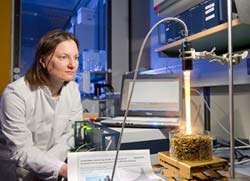Optical Analyses: More Efficient Biogas Facilities

When biomass is fermented to produce methane, acids are created, and if the acid concentration gets too high, the process collapses and the facility has to be cleaned and started up again.
Operators currently check the chemistry within the tanks by taking random samples every few days and sending them to a lab for analysis. By contrast, the new technique developed by Siemens researchers at Corporate Technology directly measures the acid content within the fermenter.
This eliminates the risk of unexpectedly high levels of acidity, thus allowing the facilities to operate at full capacity. Experts estimate that this can increase the energy yield by five to ten percent. Following successful lab tests, Siemens is now planning to launch a pilot project, as reported in the latest issue of the research magazine “Pictures of the Future”.
Biogas facilities contain bacteria that turn organic materials such as corn, wood, and manure into methane gas. This process initially produces various acids which are broken down to methane during subsequent reaction stages. If too much acid is generated too quickly, the efficiency of the methane production process declines. Even less acid is broken down as a result, causing the entire process to shut down. Facility operators can prevent the creation of too much acid by adding appropriate types of biomass such as wood, which is resistant to biodegradation.
However, the facilities are most efficient when they operate near maximum capacity. But because they don’t know how much acid is in the fermenter at any one time, many operators run the facilities at a level far below that at which the system could break down, accepting losses of up to €100,000 in the process. This problem can be solved with the help of infrared spectroscopy. Molecules produce characteristic light spectra when irradiated with infrared light.
These spectra provide information about the chemical bonds, from which the presence of certain elements or chemical groups can be deduced. The device developed by Siemens measures the fermenter’s acid content by shining infrared light through a glass window. The researchers are also developing a method for testing the quality of the biomass so that the facility can be fed in a more targeted manner.
Facility control techniques play a major role in making bioelectricity generation competitive. Over four percent of the electricity produced in Germany today is being generated by more than 5,000 biogas facilities. According to experts, the number of facilities will double by 2020.
Media Contact
More Information:
http://www.siemens.com/researchnewsAll latest news from the category: Ecology, The Environment and Conservation
This complex theme deals primarily with interactions between organisms and the environmental factors that impact them, but to a greater extent between individual inanimate environmental factors.
innovations-report offers informative reports and articles on topics such as climate protection, landscape conservation, ecological systems, wildlife and nature parks and ecosystem efficiency and balance.
Newest articles

Superradiant atoms could push the boundaries of how precisely time can be measured
Superradiant atoms can help us measure time more precisely than ever. In a new study, researchers from the University of Copenhagen present a new method for measuring the time interval,…

Ion thermoelectric conversion devices for near room temperature
The electrode sheet of the thermoelectric device consists of ionic hydrogel, which is sandwiched between the electrodes to form, and the Prussian blue on the electrode undergoes a redox reaction…

Zap Energy achieves 37-million-degree temperatures in a compact device
New publication reports record electron temperatures for a small-scale, sheared-flow-stabilized Z-pinch fusion device. In the nine decades since humans first produced fusion reactions, only a few fusion technologies have demonstrated…





















